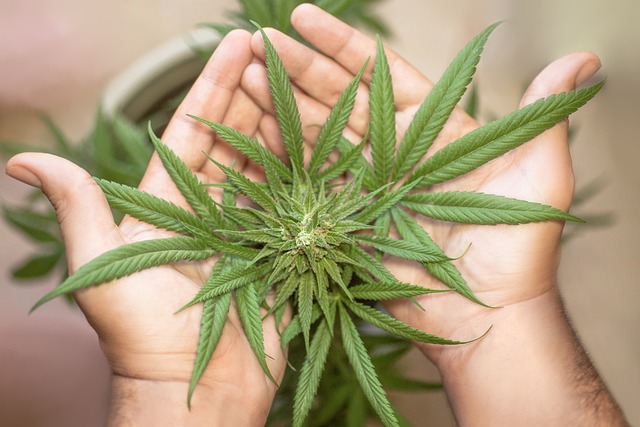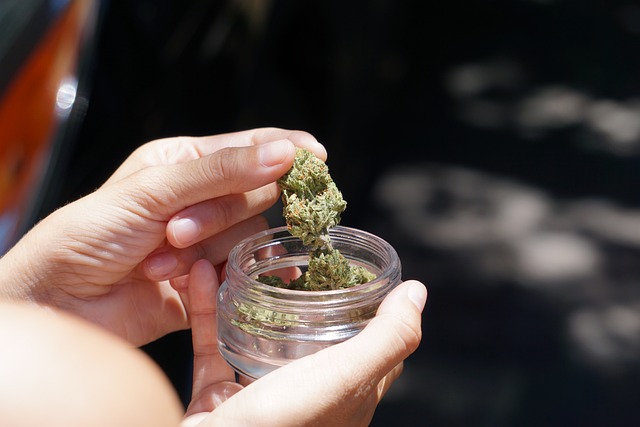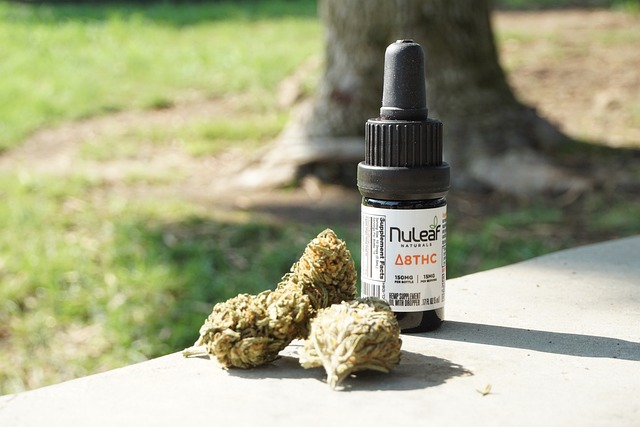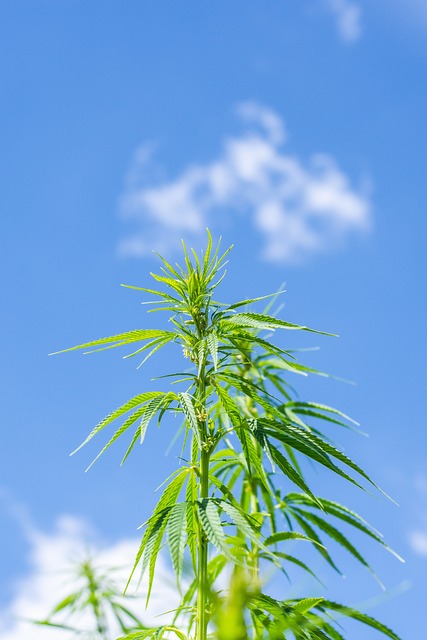The THCA flower, a non-psychoactive derivative of cannabis, is being recognized for its potential in managing pain. Unlike its psychoactive counterpart THC, THCA engages with the endocannabinoid system to alleviate various types of pain, including neuropathic and inflammatory conditions, without inducing a high. Studies show that THCA interacts with CB1 and CB2 receptors, offering anti-inflammatory benefits that could be particularly useful for chronic issues like arthritis. The THCA flower is gaining traction as a natural alternative to traditional pain relief methods due to its analgesic properties and the absence of mind-altering effects. While it's a promising option for pain management, users should start with small doses and consult healthcare professionals, especially if they have pre-existing health conditions or are taking other medications. Regular monitoring for side effects like dizziness or dry mouth is recommended to ensure safe and effective use of THCA flower for pain relief.
Exploring the multifaceted effects of THCA flower, this article delves into its potential as a natural remedy for pain management. From its biological mechanisms to precise dosage recommendations, we will navigate the science behind its analgesic properties and assess its side effects. Understanding how to effectively source and prepare THCA flower is crucial for harnessing its benefits while minimizing adverse reactions. In comparison to other cannabinoid-based interventions, THCA flower emerges as a compelling option for those seeking pain relief. Join us as we explore the nuances of this plant-based solution in the realm of therapeutic pain management.
- Understanding THCA Flower: Potential Benefits and Mechanisms for Pain Relief
- The Science Behind THCA's Analgesic Properties
- Sourcing and Preparing THCA Flower for Optimal Effectiveness in Pain Management
- Assessing the Side Effects of THCA Flower Consumption
- Navigating Dosage: Finding the Right Amount for Pain Relief Without Excessive Side Effects
- Comparative Analysis: THCA Flower vs. Other Cannabinoid-Based Pain Interventions
Understanding THCA Flower: Potential Benefits and Mechanisms for Pain Relief

Cannabinoids are a class of compounds found in cannabis plants, and THCA, or tetrahydrocannabinolic acid, is one such compound that has garnered attention for its potential therapeutic properties. Unlike its more famous counterpart THC, THCA is non-psychoactive, making it a preferred option for individuals seeking relief from pain without the mind-altering effects. The thca flower, rich in this cannabinoid, interacts with the body’s endocannabinoid system, which plays a pivotal role in regulating pain, inflammation, and the body’s homeostasis.
Research suggests that THCA may offer potent analgesic effects through its interaction with the CB1 and CB2 receptors of the endocannabinoid system. These receptors are integral to the body’s response to pain and inflammation. By binding to these receptors, THCA is believed to modulate neurotransmitter release and immune system responses, thereby providing relief from various types of pain, including neuropathic and inflammatory pain. The anti-inflammatory properties of THCA are also thought to be beneficial for conditions like arthritis, where chronic inflammation contributes to discomfort and mobility issues. As such, the thca flower is increasingly being recognized as a natural and potentially effective means for pain relief, offering hope for those managing acute or chronic pain conditions.
The Science Behind THCA's Analgesic Properties

delta-9-tetrahydrocannabinolic acid (THCA), the raw cannabinoid precursor to THC found in the cannabis plant, has been the subject of growing scientific interest due to its potential therapeutic benefits. One of the most studied properties of THCA is its analgesic effect, which suggests its role in pain relief. THCA interacts with the body’s endocannabinoid system through its receptors, particularly CB1 and CB2. These interactions modulate various physiological functions including pain sensation and inflammatory responses. Research indicates that THCA may inhibit neuronal transmission in pain pathways by binding to nerve cells, thereby reducing the perception of pain. This mechanism is believed to be responsible for its analgesic effects, making it a potential candidate for natural pain relief.
Furthermore, studies have shown that THCA possesses anti-inflammatory properties, further contributing to its analgesic effects. The anti-inflammatory action of THCA is thought to stem from its ability to suppress pro-inflammatory cytokines and enzymes involved in the inflammatory process. This dual action of modulating both pain sensation and inflammation positions THCA flower as a promising alternative for individuals seeking natural relief from chronic and neuropathic pain without the psychoactive effects associated with its decarboxylated form, THC. The exploration of THCA’s analgesic properties continues to be an area of active research, offering insights into the potential benefits of this cannabinoid for pain management.
Sourcing and Preparing THCA Flower for Optimal Effectiveness in Pain Management

sourcing high-quality THCA flowers is paramount for those seeking effective pain relief. It’s crucial to procure from reputable sources that offer lab-tested products to ensure potency and purity. The right strain can make a significant difference in the efficacy of pain management; for instance, strains with higher levels of THCA are often favored due to their potential analgesic properties. Proper preparation techniques are also essential. To harness the full benefits of THCA flower for pain relief, consider various consumption methods such as vaporizing or smoking, which can offer immediate effects. Alternatively, infusion into edibles or topicals allows for a longer-lasting impact, suitable for chronic pain conditions. Precise dosing is key; starting with smaller amounts and gradually increasing as needed ensures a personalized approach to pain management, minimizing the risk of adverse side effects. It’s also important to store the THCA flower properly, in a cool, dry place away from direct sunlight to maintain its integrity and potency over time. By carefully selecting and preparing your THCA flower, you can maximize its effectiveness for managing pain in a way that aligns with your specific needs and lifestyle.
Assessing the Side Effects of THCA Flower Consumption

When exploring the therapeutic potential of THCA flower, it’s crucial to consider its side effects, particularly in the context of pain relief. THCA, or tetrahydrocannabinolic acid, is a non-psychoactive cannabinoid found in hemp and cannabis plants, known for its analgesic properties. While THCA flower has shown promise in alleviating various types of pain without the intoxicating effects associated with THC, it’s not without potential side effects. Users may experience mild to moderate adverse reactions, which can include dizziness, dry mouth, and altered mood. It’s important for individuals considering THCA flower for pain relief to approach its use with caution, starting with low doses to gauge their body’s response. Additionally, while the side effects are generally considered minor, those with pre-existing health conditions or taking other medications should consult a healthcare professional before incorporating THCA flower into their regimen. This is because interactions between cannabinoids and other substances can affect how drugs work in the body, potentially altering their efficacy or safety profile. Monitoring one’s intake and observing how the body adapts to THCA flower can help mitigate any negative effects, ensuring a safe and beneficial experience for those seeking relief from pain without psychoactive influence.
Navigating Dosage: Finding the Right Amount for Pain Relief Without Excessive Side Effects

When incorporating THCA flower into one’s wellness regimen for pain relief, it is crucial to approach dosage with both caution and precision. The non-psychoactive cannabinoid THCA, found in raw or decarboxylated cannabis flowers, has shown potential in alleviating various types of pain without the mind-altering effects associated with its more well-known counterpart, THC. To harness the analgesic properties of THCA flower effectively, individuals should start with a low dosage to gauge their body’s response and gradually increase intake as needed, while remaining within a safe threshold. The suggested starting point is typically around 1-5 milligrams of THCA per day, which can be adjusted based on individual tolerance, pain severity, and body weight. It’s important to monitor one’s reaction closely, as higher doses may lead to undesirable side effects such as drowsiness or gastrointestinal discomfort. Users should also consider the method of consumption, as different administration routes—such as inhalation, capsules, or sublingual application—can affect how the body processes THCA and, consequently, the dosage required for pain relief without excessive side effects. Adjusting to the right dosage is a process of personal discovery and should be approached with patience and an understanding of individual biochemistry. By starting low and going slow, users can optimize the benefits of THCA flower for pain relief while minimizing potential adverse effects.
Comparative Analysis: THCA Flower vs. Other Cannabinoid-Based Pain Interventions

When considering cannabinoid-based interventions for pain management, THCA (Tetrahydrocannabinolic Acid) flower emerges as a notable alternative to traditional treatments and other cannabinoid forms. Unlike its psychoactive counterpart, THC, THCA does not induce intoxication, offering a clear-headed pain relief option for many individuals. The unique properties of THCA flower have been the subject of increasing scientific scrutiny, with research suggesting its efficacy in targeting various types of pain, including neuropathic and inflammatory pain conditions. Unlike certain other cannabinoids like CBD (Cannabidiol), which may also offer therapeutic benefits, THCA’s interaction with the endocannabinoid system appears to be particularly adept at alleviating discomfort without the sedative effects commonly associated with opioid-based painkillers. Additionally, anecdotal evidence and preliminary studies indicate that THCA flower may possess anti-inflammatory and analgesic properties, making it a promising candidate for those seeking effective pain relief without significant side effects often associated with pharmaceutical options. In contrast to topical applications or edibles containing CBD or other cannabinoids, the THCA flower can be administered through smoking or vaporizing, offering rapid onset of relief for acute pain episodes. This direct administration method allows for precise dosing and quick symptom management, which can be particularly beneficial for conditions like arthritis or menstrual cramps where immediate relief is often sought after. As with any treatment option, it is advisable to consult healthcare professionals before incorporating THCA flower into one’s pain management regimen, ensuring compatibility with individual health profiles and existing medical conditions.
In conclusion, thorough exploration of the THCA flower’s potential as a natural analgesic has revealed promising benefits for those seeking pain relief. Its interaction with the body’s endocannabinoid system provides a compelling scientific basis for its use in managing various types of discomfort. While preparing and consuming THCA flower can be an effective approach, it is imperative to approach dosage with caution to mitigate any side effects that may arise. Users should consider personal tolerance and consult healthcare professionals before integrating THCA flower into their pain management regimen. Comparatively, THCA flower stands as a noteworthy alternative in the landscape of cannabinoid-based interventions, offering a distinct set of advantages for pain relief without the psychoactive effects associated with other cannabis derivatives. As research continues to evolve, the understanding and utilization of THCA flower are likely to expand, further solidifying its role in natural medicine.
